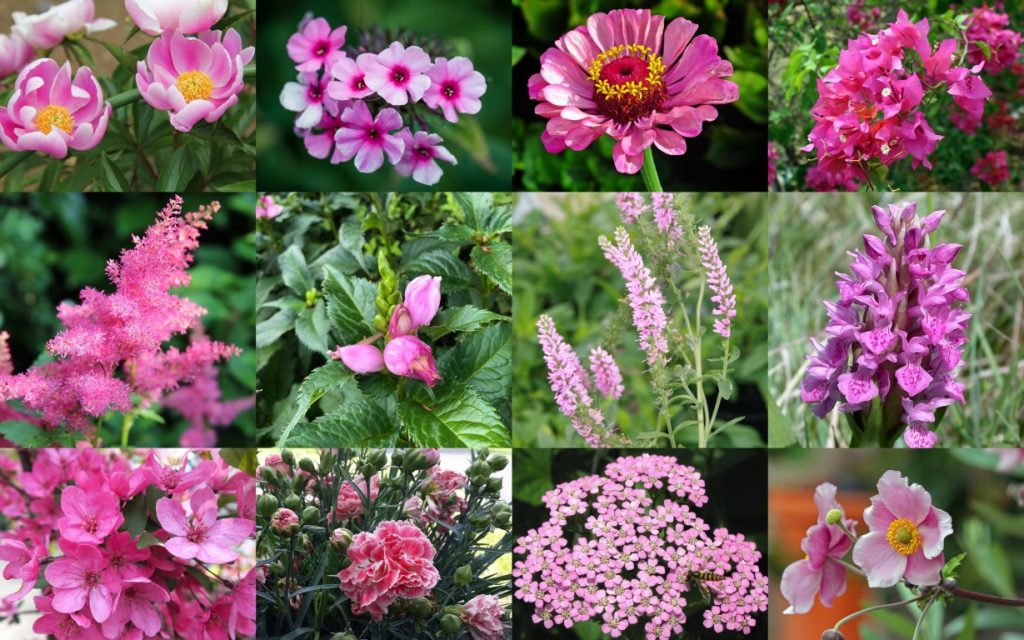Pink color is one of the most preferred for gardens as many people associate it with romance and tenderness. It is a common color for flowers and is usually enjoyed most when one is happy and fulfilled.
In this guide, you’ll discover all the possible meanings and symbolism of pink color, and our choice of the most beautiful pink flowers that you will appreciate and enjoy.
- Pink Color Meaning
- Top Flowering Trees with Beautiful Pink Flowers
- Roses
- Lily
- Lilac Bush
- Allium
- Hyacinth
- ‘Dark Eyes’ Fuchsia
- Peony
- Tulip
- Dianthus
- Camelia
- Yarrow
- Lychnis Coronaria
- Petunia
- Rhododendron
- ‘Raspberry Wine’ Bee Balm
- Wisteria
- Hibiscus
- Hydrangea
- Amaryllis
- Lupine
- Periwinkle
- Forget-me-not
- Thyme
- Columbine
- Geranium
- Aster
- Pink Daisy
- Delphinium
- Violets
- Antirrhinum
- Chrysanthemum
- Trifolium Rubens ‘Red Feathers’
- Bergenia
- Rose Thrift
- Cherry Tree
- Coneflower
- Dahlia
- Anemone
- Mandevilla
- Snapdragon
- Dactylorhiza
- Hollyhock
- Crabapple Tree
- Veronica
- Turtlehead
- Astilbe
- Carnation
- Heuchera
- Bleeding Heart
- Iberis
- Foxglove
- Bougainvillea
- Zinnia
- Phlox
- Paeonia Lactiflora
- What Are Some Other Beautiful Pink Flowers?
- How to Choose Pretty Pink Flowers That Work Well in Your Garden
- Pink Flowering Plants for Any Gardener
Pink Color Meaning

Pink is the symbol of femininity, love, romance, and tenderness. It is a common choice for gardens as it is also known to contribute to calm, relax and carefree mindedness (1).
Scientists researching the response of humans to colors also claim that pink is associated with certain emotions, feelings and character features, such as softness, sweetness, security, being safe and nurture (2).
Studies also relate this color to individual features and suggest that people preferring light pink color in their every-day life are organized, good planners and sticking to already formed habits rather than lovers of trying something new (2).
Pink color is associated with positive emotions and is believed to be a source of smiles and positive vibes. It is perceived as one of the most romantic and attractive colors which, at the same time, is cheerful and playing (3).
Pink Flower Meaning in Different Countries

It is interesting to note that colors have varying meanings in different countries. For example, in Thailand pink is a symbol of trust. In the United States, it is used to identify femininity, childhood, sweetness, and homosexuality.
In Western Europe, the color pink is used to show delicacy, flirtation, and sensitivity. In Japan, stunning pink flowers are considered to symbolize the beginning of the spring season, femininity, youth and a wish for good health and in India, pink is used to express happiness and hope (4). The stunning cherry blossom trees bloom in the most magnificent light pink display.
These are just some of the reasons why all of us love having small pink flowers in our gardens. This guide will walk you through our top choices for pink flowering plants that you will enjoy.
Top Flowering Trees with Beautiful Pink Flowers
Roses
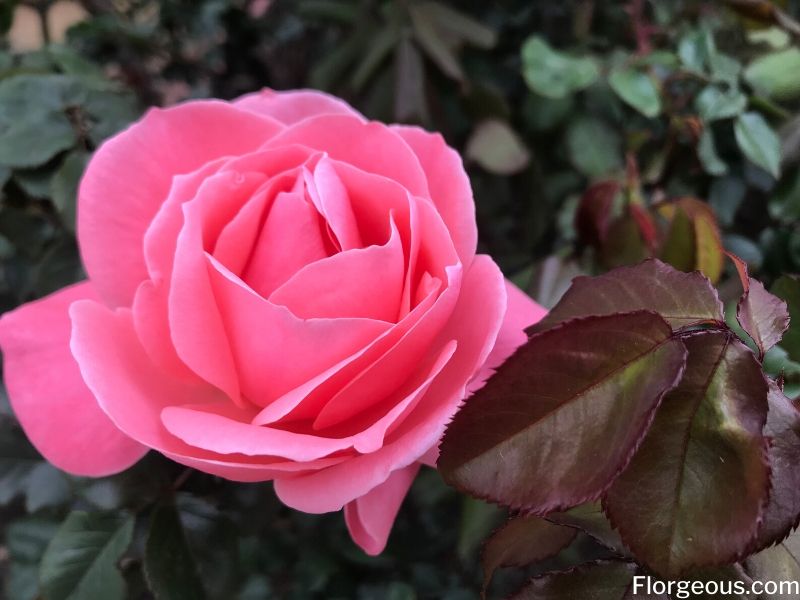
Roses are among the most preferred pink flowers for both garden design and cut floral decorations due to their beauty, perceived association of love and care and aromatic fragrance. Roses have been cultivated in China more than 5,000 years ago and have been referred to by ancient Romans and Greeks in their myths and stories.
Roses come in a wide variety of shapes, forms, fragrances, and colors such as black, blue, purple, white, pink, orange, green, red, and yellow, etc…
Depending on your preference you can choose bushes, vines, different scale of coverage etc… More than 100 species come under Rosa genus, so you can definitely find the one that suits your imagination and desired design most.
Maintenance and growing would depend on the type chosen, so for more reference, you can visit our rose guide here.
Lily
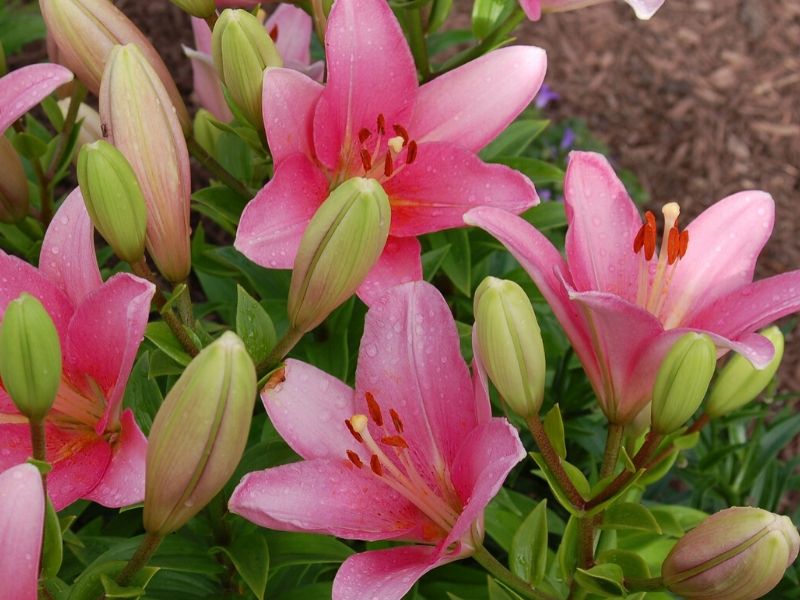
Lilies are varying in types and colors but, whichever you choose, it would always be a breath-taking addition to your garden. Lilies are relatively easy to grow, amazingly beautiful and blooming continuously from early to midsummer.
They are usually growing up to 3 feet tall and grow better if planted in a place with a lot of sunshine during the day. They prefer regular watering but well-drained soil to bloom continuously and for longer.
The easiest method to plant lilies is to use bulbs. These gorgeous pink flowers are easy to grow and if taken care of properly, they bloom every year.
Lilac Bush
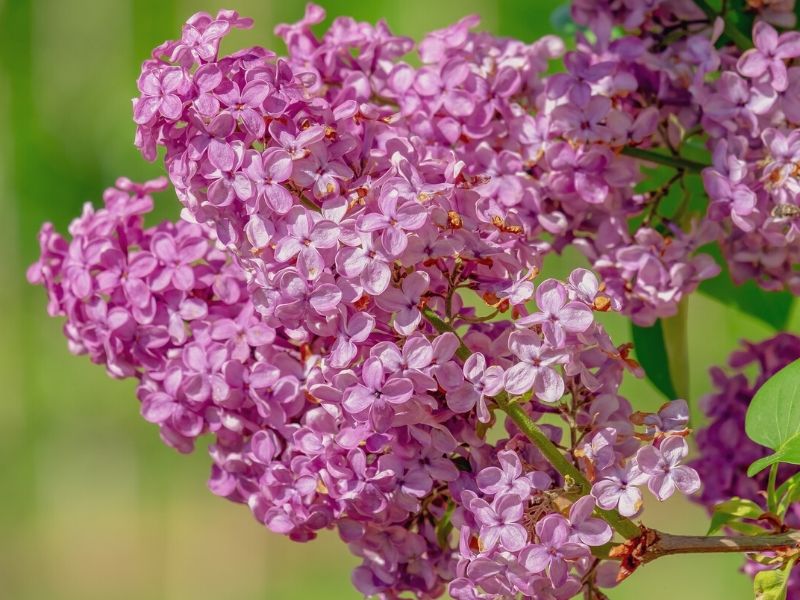
Lilac bushes are deciduous plants that are blooming in late spring. They are distinctive due to the strong fragrance of the flowers and the rich colors they come in, the most common of which are white, purple and shades of pink.
Lilacs are very common for the Balkan Peninsula in Europe, but can also be grown in other areas across the globe. The fragrance of lilacs is often used in the perfumery and cosmetics industry.
The bushes reach 16 feet tall and 12 feet in width. They bloom more and longer when exposed to full sun and planted in neutral and well-drained soil.
Lilacs enjoy regular watering but without keeping the soil wet for too long. These beautiful bushes can be an amazing border flower for fences and building hedges. To encourage blooming, you might trim the overgrown flowers.
Allium
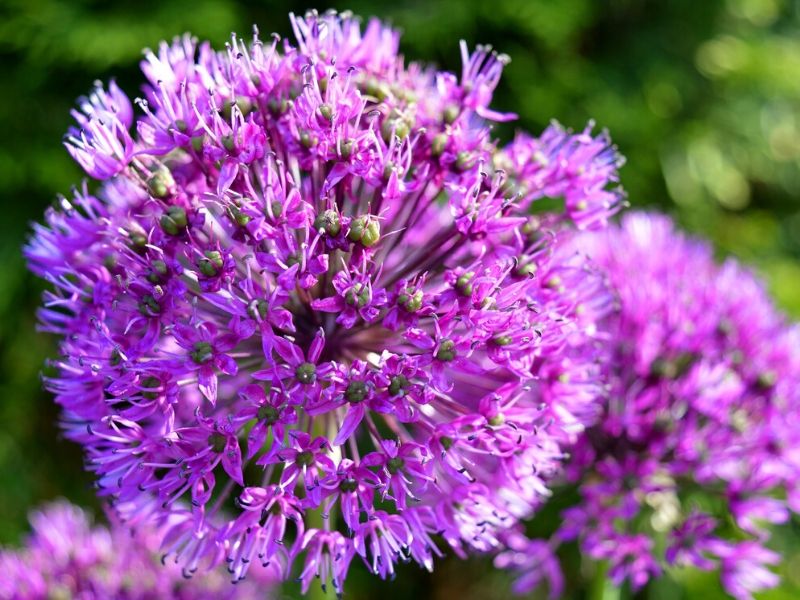
Alliums are also amazing additions to any garden. They come in a wide variety of colors, blooming times, height and shapes which makes them perfect for completing any garden design.
Tall varieties can also be used as cut flowers for vase decorations and bouquets. The most common type of allium used in gardens has tall stains and a globe-shaped flower on top which makes them a good background or accent of a garden which is dominated by shorter flowers.
Alliums grow best and fastest when exposed to full sun or partial shade and also prefer well-drained soil.
Hyacinth
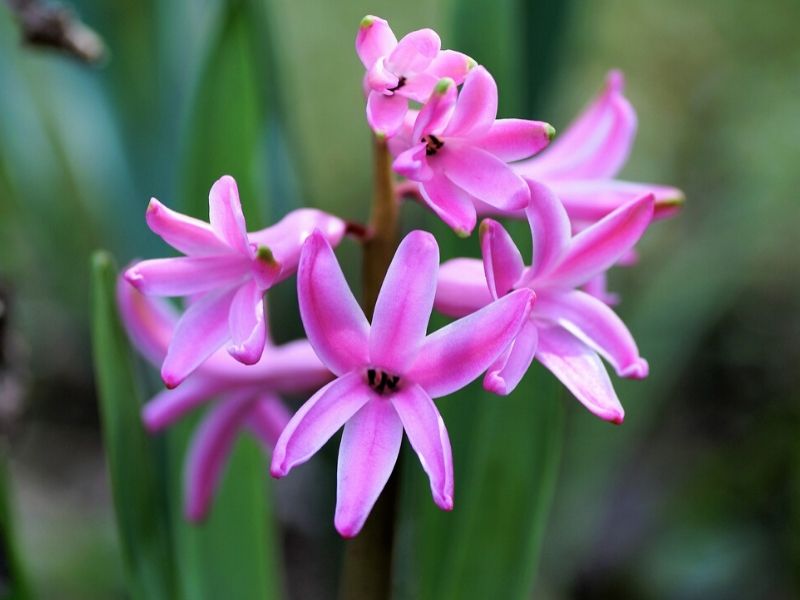
Hyacinths are some of the most symbolic spring flowers. They have a very strong distinctive fragrance which is often used in perfumery and cosmetics nowadays.
Due to the relatively low maintenance, rich colors, impressive bright pink flowers, and strong fragrance, these flowers are very often used in park and garden decorations to create a spring fairy tale.
Hyacinths come in a wide range of colors, including white, pink, blue, purple and burgundy. Despite being a spring flower, you can also have hyacinths in other periods of the year, like Christmas for example.
‘Dark Eyes’ Fuchsia
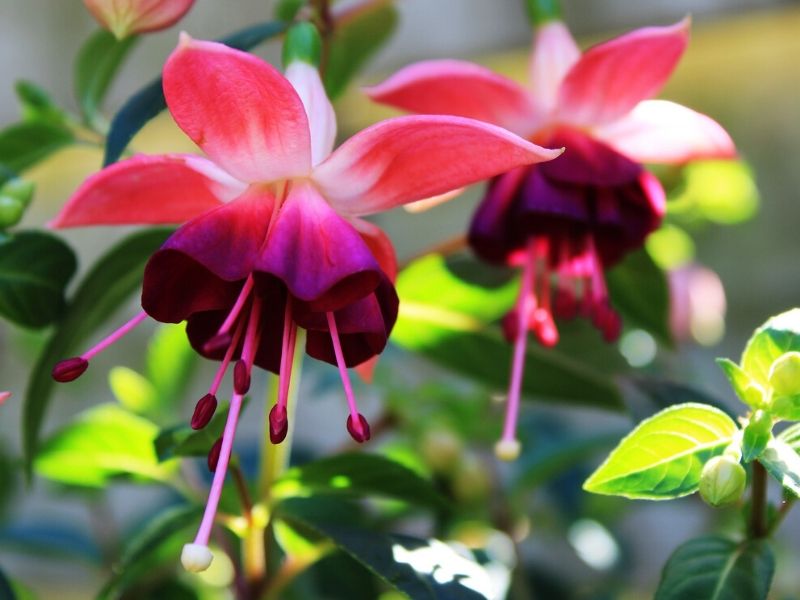
Despite being an annual flower, the ‘Dark Eyes’ fuchsia is always a superstar in a garden environment due to its amazingly pretty draping, lantern-like flowers that usually come in two overflowing colors.
Fuchsias are usually planted in hanging pots for a greater colorful and blooming effect. The plant can grow up to 30 inches in height and width. It can develop well in a variety of light conditions from full sun to full shade and enjoys well-drained soil and regular watering.
Peony
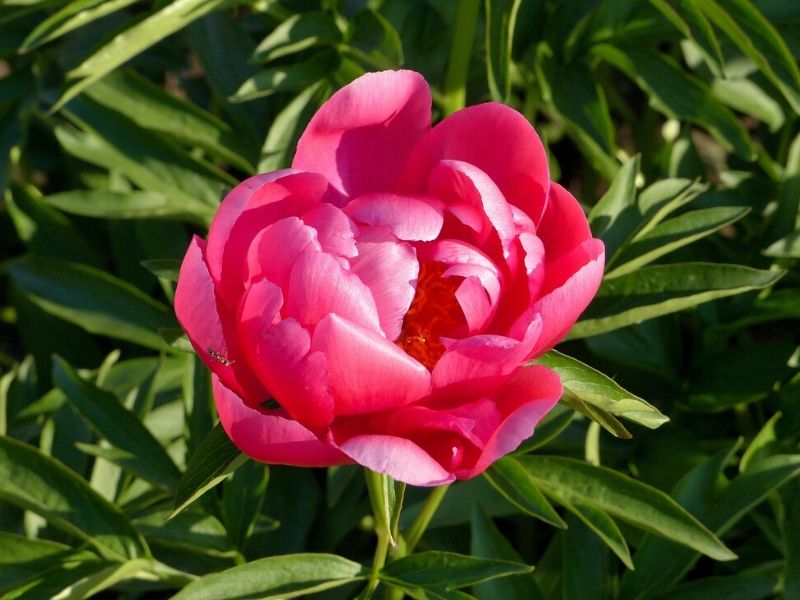
This is one of my personal favorite perennials. It comes in different varieties and rich color palette, including pink, white, red, burgundy and purple. Peonies bloom in late spring and their flowers impress with size and strong aromatic fragrance which is also often used in cosmetics and perfumery.
Peonies attract butterflies which can further contribute to your home fairy-tale-like paradise. The flower can grow up to 4 feet in height and width and, to bloom more and longer, it prefers full sunlight during the majority of the day time, as well as moist and well-drained soil. It enjoys regular watering too.
Tulip

Tulip plants are definitely one of the top gardeners’ choices with their tubular flowers when it comes to planning a spring blooming garden. They come in an extremely rich variety of sorts, color palettes and forms, which can satisfy even the most pretentious tastes and preferences.
Tulips are blooming in the spring and if the bulbs are cared for, they can last for decades and reward your garden with flowers every year. If you don’t remove the bulbs from the ground they might also start self-spreading, so keep this in mind when choosing the area to plant them.
Regardless of the differences based on specific sorts and varieties, tulips generally prefer full sunlight and well-drained soil, as well as regular watering. They can grow on average up to 15 inches in height and 6 inches in width. Despite blooming only for a week, it is definitely worth having tulips in your garden, you will have no regrets!
Dianthus

These small flowers can make an amazing pink carpet in your garden. They come with a strong aromatic fragrance and grow best in full sun and well-drained soil.
They can grow up to 6 inches in height and 18 inches in width and can also spread relatively easy, so keep this in mind when you choose the area to plant them.
Camelia
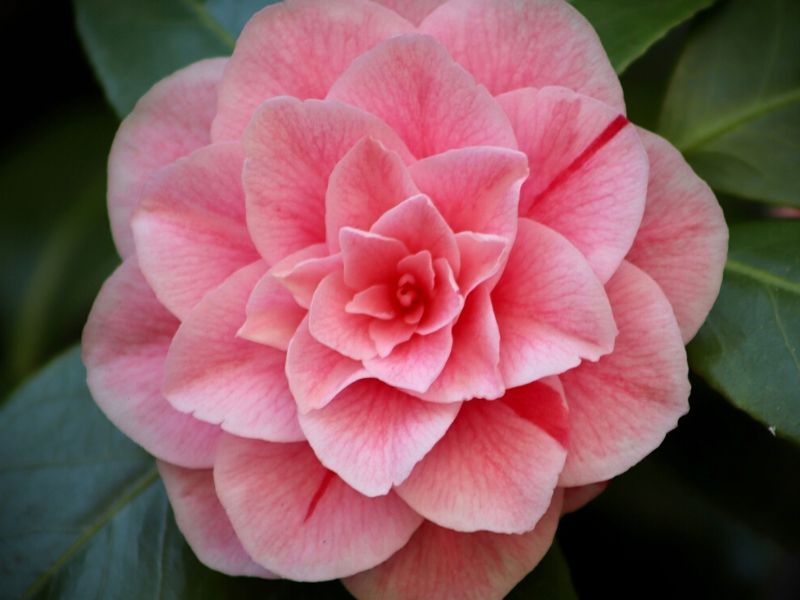
This plant is relatively easy to grow and care and require minimum maintenance. It enjoys sunlight and blooms almost all year-round if not exposed to heavy winter conditions.
Camellia flowers are very gentle and primarily come in soft pink color variations. It prefers moist and rich soil and moderate sunlight.
Yarrow

This is very often classified as gardeners’ favorite due to its relatively strong resistance and rich colorful flowers which are growing on the top of stains covered with feathery leaves.
Yarrows are very often used in dry floral decorations and as cut flowers as they can grow up to 24 inches of height.
Yarrows bloom more when exposed to full sunlight and planted in well-drained soil. Some people use yarrow leaves and blossoms for medical treatment of pain and wound-healing.
Lychnis Coronaria
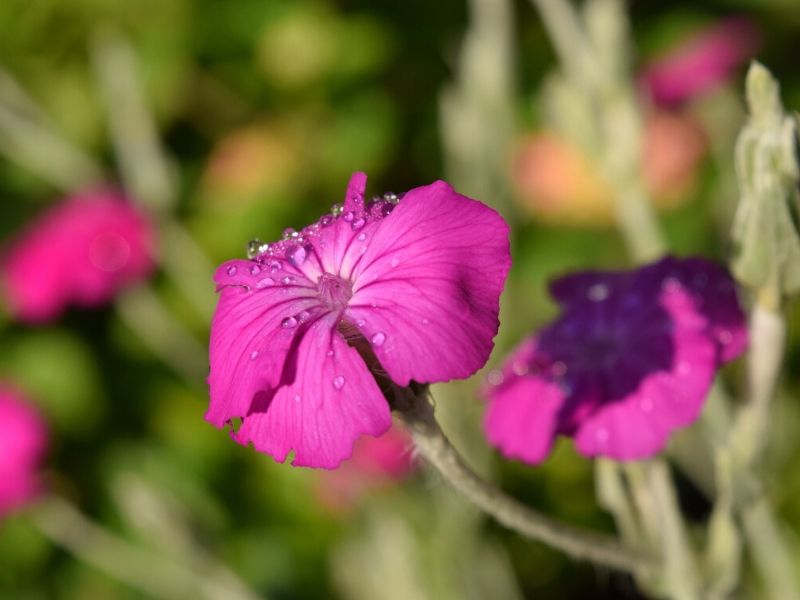
Despite being a short-living perennial which lasts only a couple of years, having this flower in your garden is a rewarding experience.
It has beautiful green foliage with rich-colored pink flowers on the top of tall stains. It blooms most and longest when exposed to full sunlight and planted in well-drained soil.
Petunia
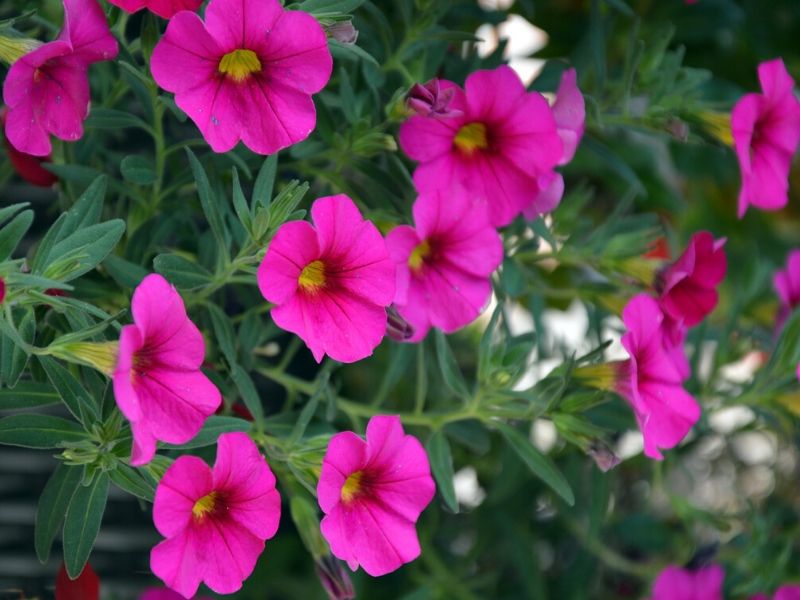
Petunias are one of the most preferred summer annuals as they come in rich color palette variety and are relatively easy to grow and care. Many gardeners are planting them in hanging baskets and mix colors to make a colorful fairy of beauty in their gardens.
Petunia can come in different sorts, including hanging and non-hanging which makes it a perfect fit for different design purposes in your garden. It can grow up to 4 feet in height and width depending on the sort chosen.
It blooms most and longest when exposed to full sunlight and planted in well-drained soil. Petunia flowers are enjoying a lot of watering, so you have to keep this in mind when planning your garden activities.
In order to encourage blooming, you can remove the dead flowers from the branches. If taken care of well, petunia will reward you with blooming during the whole summer season.
Rhododendron

Despite being considered as relatively difficult plants to grow and care, rhododendrons reward garden owners with long-lasting and amazingly beautiful flowers blooming in spring, summer and autumn.
These bushes come in different sorts, size, shape and color varieties including pink, purple, red and burgundy. Rhododendron trees can grow up to 14 m height, so you might keep this in consideration when making long-term plans for your garden.
Rhododendrons prefer partial shade or sunny areas but need protection in case of extreme climate conditions (e.g. direct sunlight for long hours of daytime or too cold weather).
Different types require different maintenance routine in terms of soil preference, watering, temperature and climate requirements. For more details, you can refer to our rhododendron guide.
‘Raspberry Wine’ Bee Balm
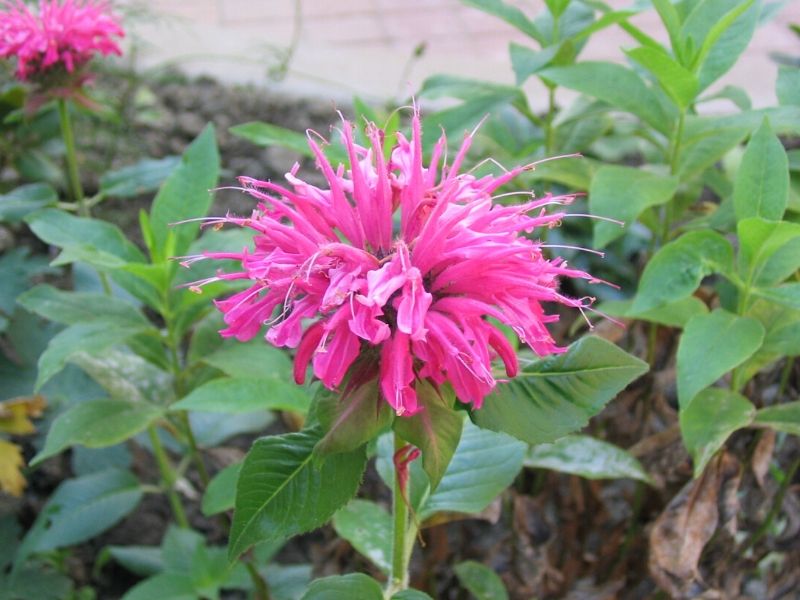
This flower is named after its known ability to attract bees, butterflies, and hummingbirds which can transform your garden in a real paradise.
This is due to its distinctive fragrance which is very strong and sweet. The blooms of this flower are usually coming in rose to red colors and can be enjoyed from mid to late summer days.
This plant can become up to 30 inches tall and grows best when planted in a fully sunny position or partial shade. It enjoys regular watering but well-drained soil.
Wisteria
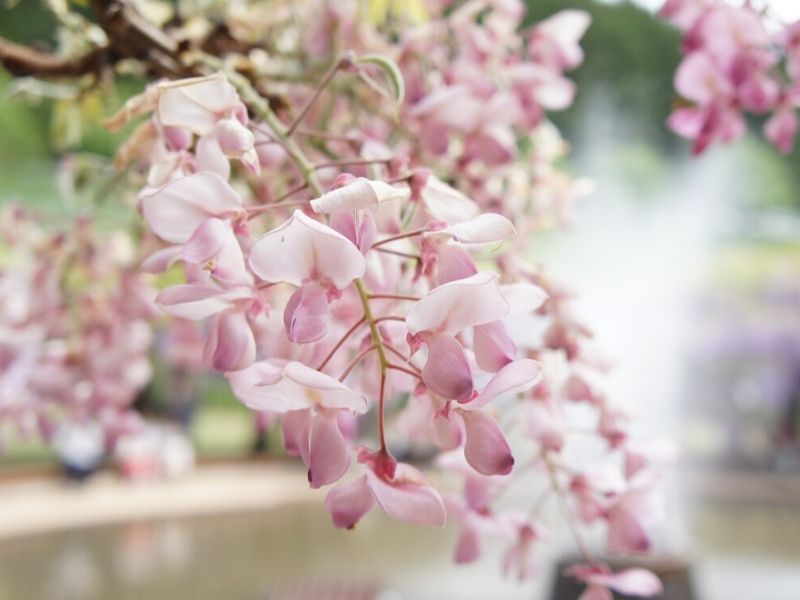
This flower comes as a high-climbing vine and blooms during the spring season with large clusters of smaller blossoms. It is very often used for cascading garden decorations due to its breath-taking flowers coming in a variety of colors, including blue, pink and purple.
The plant can reach up to 30 feet long stains which are easily climbing on a variety of support systems and wall covers, so you might keep this in mind and plant them away from areas which you don’t want to be covered by it.
Wisteria flowers have a very aromatic fragrance and attract butterflies and birds. Wisteria blooms only on sunny places and if planted in moist but well-drained soil. It is a good idea to plant wisteria vines away from other plants to prevent overtaking them through fast-growing.
Hibiscus
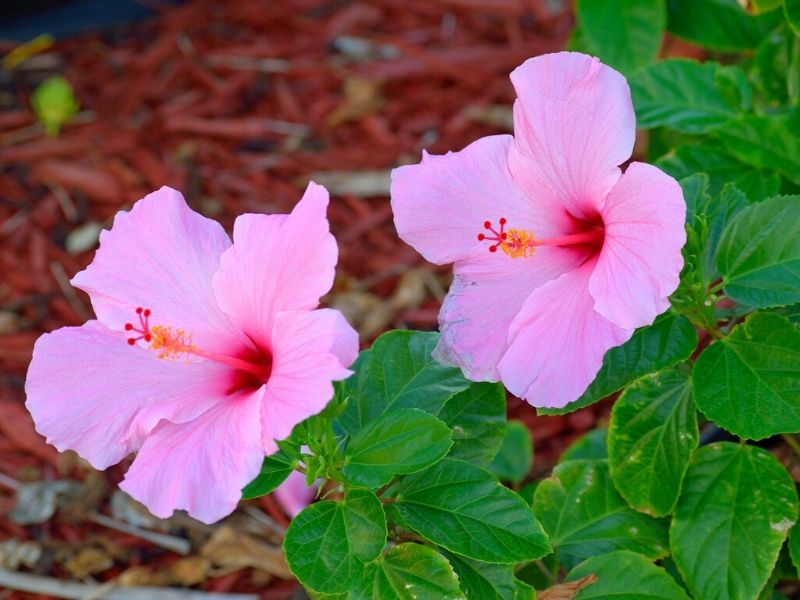
Hibiscus is my personal favorite and I enjoy my hybrid three-colored bush in three out of four seasons in total. It blooms in spring, summer, and autumn.
This flower comes in many different colors ranging from white to dark red, burgundy, purple, pink, yellow, blue and even black. It prefers full sunlight for the majority of the day and regular watering but well-drained soil.
Despite the fact that the blossoms last only a couple of days, their beauty is indisputable and they are replaced with new flowers very fast.
Hydrangea
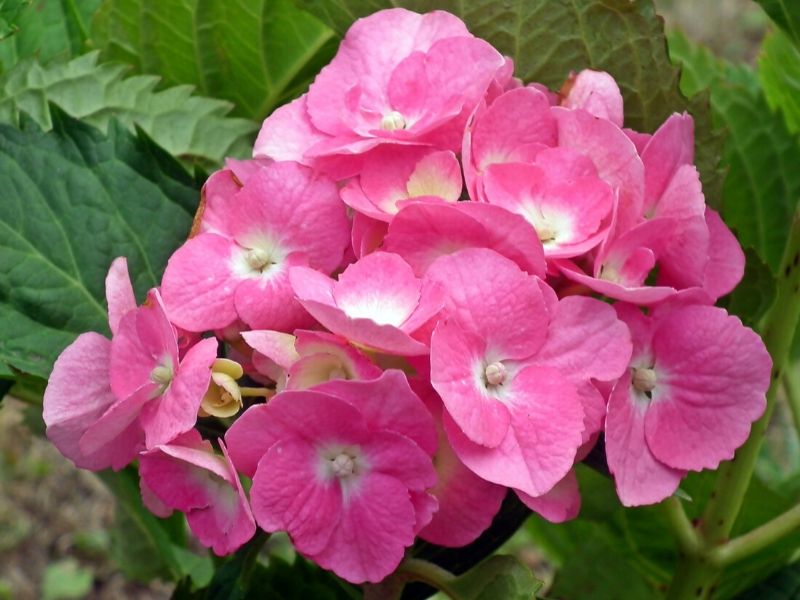
If you plant hydrangea in your garden, it will certainly become an eye-catcher. The plant comes in many color options and the brightness of each depends on the alkalinity of the soil.
The flower is relatively well resistant to heavy winter conditions and thus, it can grow in areas with colder winter seasons. Hydrangeas start blooming in early spring and this continues until the autumn.
The foliage and green leaves fall during the winter and are replaced by a new one in the spring. In order to make the plant stronger and encourage more blooming, you can trim the branches before the new foliage comes out in the spring.
However, be careful not to do that during periods of too low temperatures as this might cause freezing of the branches.
Amaryllis
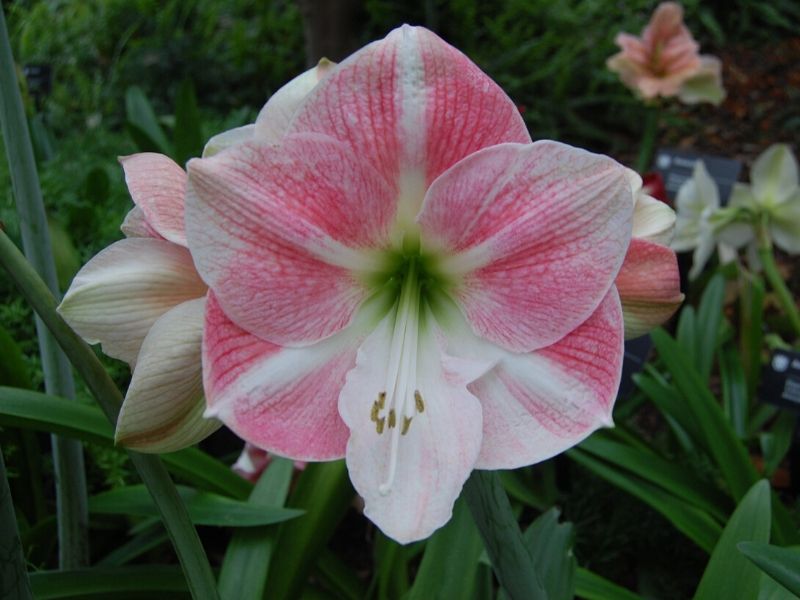
The Amaryllis is a breath-taking flower which blooms relatively rare but this is a very rewarding experience. The flower is trumpet-shaped and is positioned on the top of a leafless stain which is up to 2 feet tall.
Each bulb of this gorgeous flower can bloom for up to 75 years in blossoms which are up to 10 inches in size. It comes in many and rich colors, including pink, white, red, burgundy, purple and apricot.
Amaryllis can easily be grown in a pot outdoors but should be moved indoors during the winter season as it can hardly survive frost, snow, and low temperatures. This plant enjoys a lot of sunlight. When planting, keep in mind that the bulb should not all be covered with soil.
Lupine
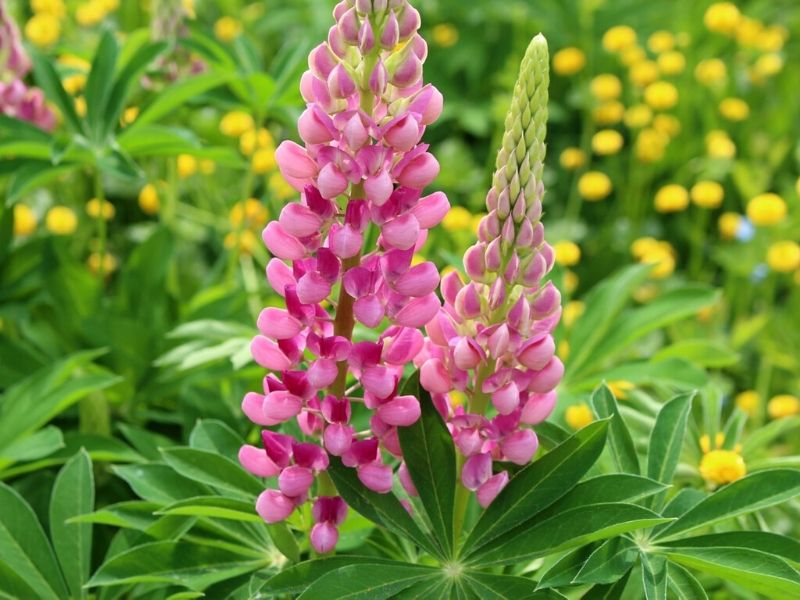
Lupines are very often used as cut flowers for floral decorations because of their height. They grow well in areas with well-drained soil and full sunlight during the majority of the day.
These beautiful blossoms come in a variety of colors, including pink, purple and blue. The flower can grow up to 5 feet which makes it a good background of shorter plants or a beautiful center filling of a garden area.
Keep in mind that this is one of the plants which need a ‘resting period’ in order to develop strong. This is why if you grow it from seeds, keep them in the fridge wrapped in paper for a week before planting. This will help them grow better, stronger and faster.
Periwinkle
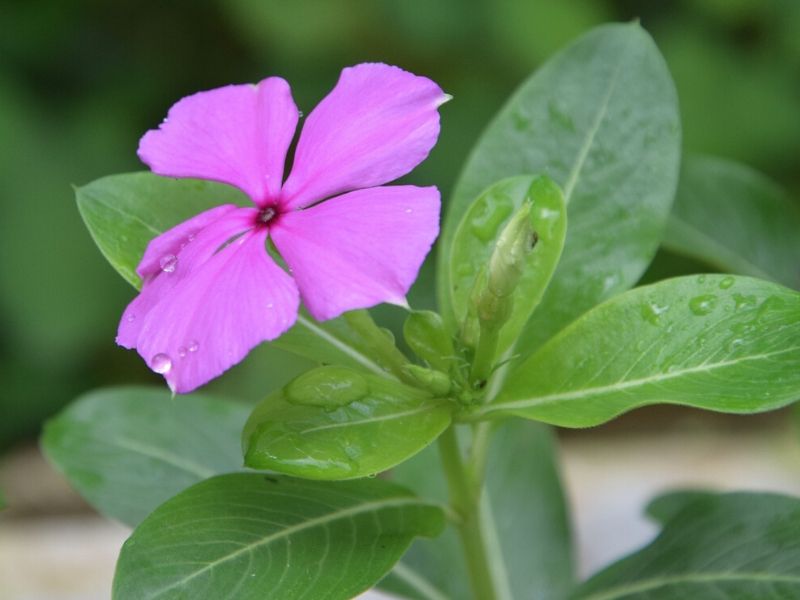
Due to the relatively short height of this flower, it is often the gardeners’ choice for ground cover and background of taller plants. The color variety of its blossoms includes pink, blue and purple.
Other colors, like burgundy, are rarer. Once it is developed well, it spreads easily, so keep this in mind when you plan the planting area. It grows best in areas which are characterized with partial shade and no direct sunlight for a long part of the daytime as, otherwise it burns.
When the plant grows, it is relatively resistant to drought and changing climate conditions, which makes it easy to grow and care.
Forget-me-not
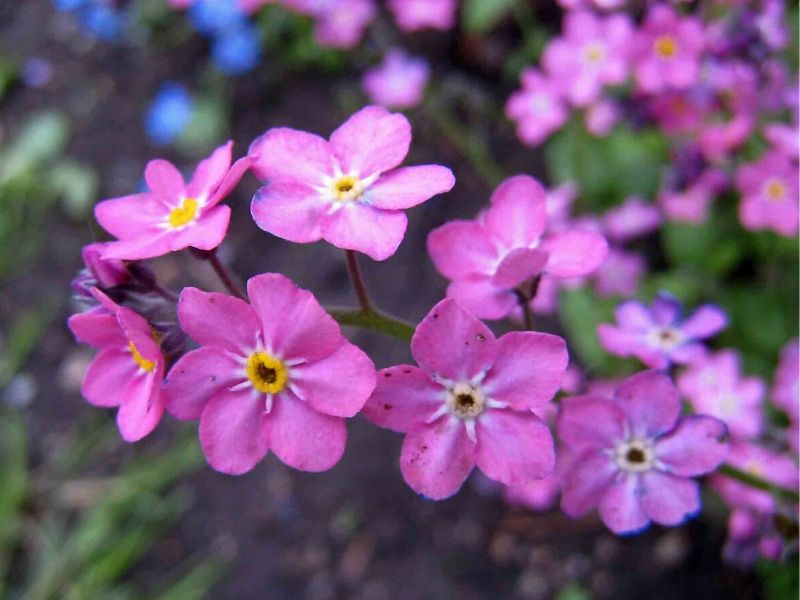
This flower is named after stories from the past referring mainly to warriors who were wearing it to not be forgotten by their girls before they come back home.
Nowadays, this flower is used in gardens because of its gentle beauty and easy self-spreading. The main color varieties that you can find include pink and blue.
It prefers moist soil and shady area with no direct sunlight for long. It is very often used for ground cover purposes and turning a large empty area into a colorful paradise.
Thyme
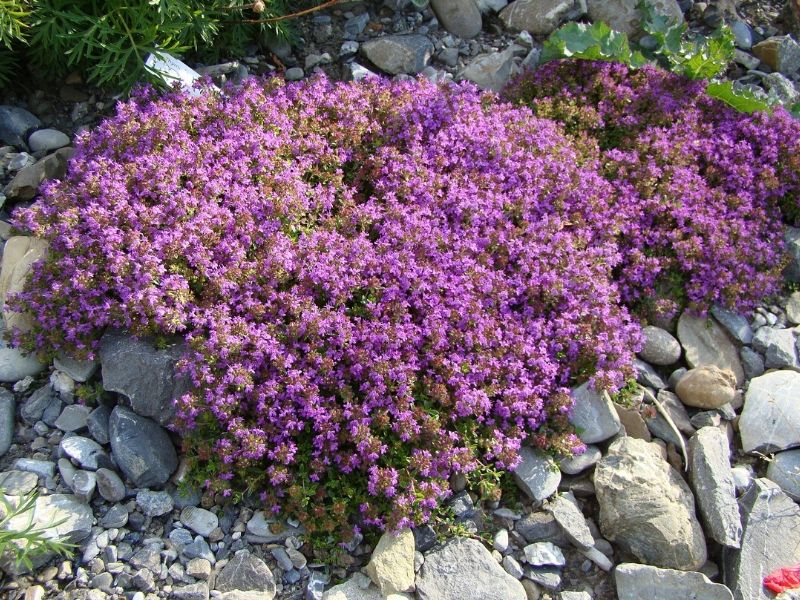
Despite being an amazing herb which is often used for cooking and making tea, thyme is also a great addition to garden designs. It grows relatively low in height which makes it perfect for ground cover purposes, for using it to define borders or alongside pathways.
Apart from blooming with pretty pink blossoms, thyme will also reward you with aromatic fragrance of fresh herbs during the whole blooming season.
Columbine
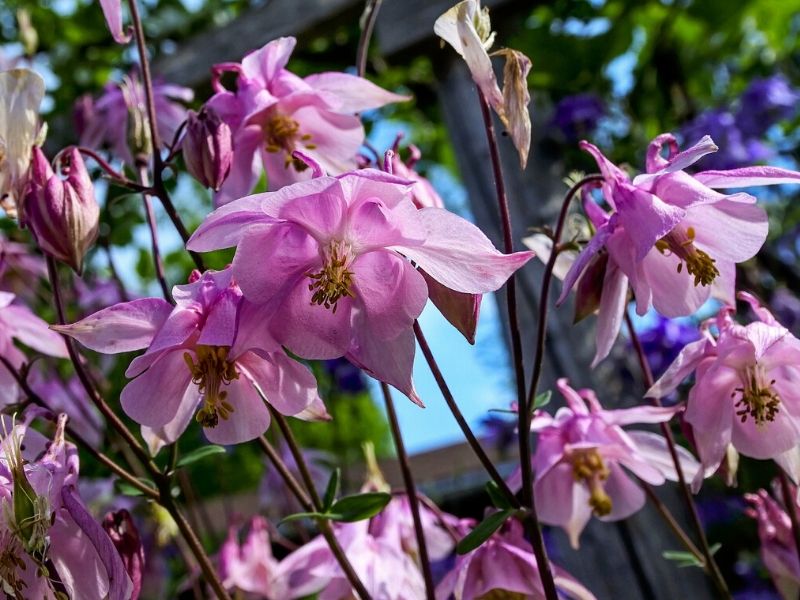
These flowers can also contribute to the creation of your own back-yard heaven. They are very often chosen from garden planners because of their gentle beautiful flowers and the fact that they attract hummingbirds.
The main color varieties of Columbine include pink, blue, red, yellow, white and violet. This flower grows best in well-drained soil and full sunlight during the majority of the daytime. It also prefers mild climate areas.
However, as it is quite resistant to varying conditions, it can easily be grown in other zones and partial shade positions. If you live in an area with colder winter, it is advised that you put mulch for insulation and keeping the soil moist or use another type of protection.
Geranium
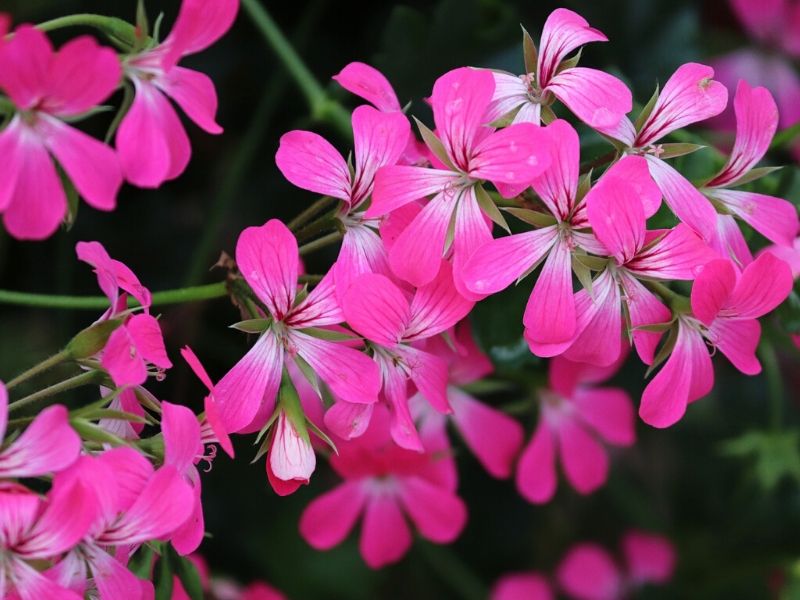
Geraniums are a favorite gardeners’ choice due to their long blooming periods. They come in a wide variety of colors, including pink, blue, white, yellow, red, apricot, burgundy and purple.
They start blooming in the spring and this continues in the summer and autumn seasons, until the first frost. This flower grows best in areas with well-drained soil and full sunlight during the majority of the day.
It can grow up to 14 inches high and 30 inches width. You can also use it for different purposes, including floral baskets and border pots.
Aster

This flower is often used in planning an autumn garden paradise and is a perfect end of your blooming season for the year. The color range of the flower is extremely rich, including a palette ranging from white, pink, blue, yellow, purple, orange, apricot to dark burgundy.
It is often referred to as “frost flower” as it blooms until winter and the first frost. It is resistant to changing climate conditions and colder temperatures. It prefers regular watering but well-drained soil and partial sunlight for the majority of the day, but is easily adaptable to other environments too.
In the past, kings were requesting to have asters in their gardens because it was believed that the flower sends evil away which is also the reason why it has been used in ancient rituals and symbolic traditions too. Did you know that Aster is a September birth flower?
Pink Daisy
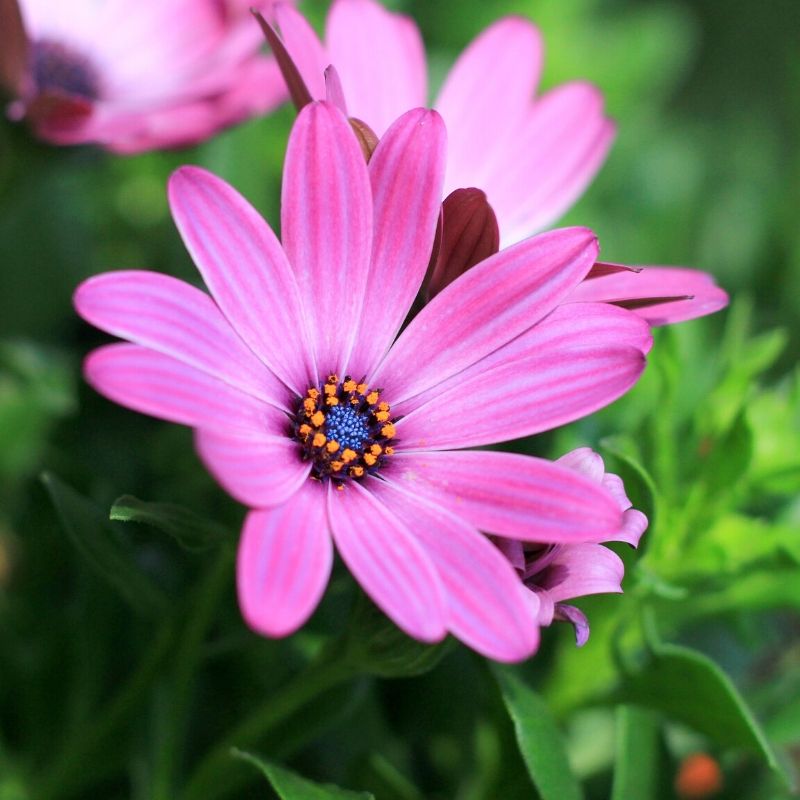
Daisies are a classic choice for gardens, regardless of the sort and color preference selected. The palette of this flower ranges from white, through pink to blue and purple.
Daisies are relatively easy to grow and care and spread relatively fast once they are developed. They are considered well resistant to changing climate conditions which makes them appropriate for almost any garden design.
They are also not so water-demanding which further contributes to the ease of their maintenance. If you want to encourage and support more and longer blooming, you might remove the dead flowers from the stains which will be replaced by new ones very fast.
Delphinium
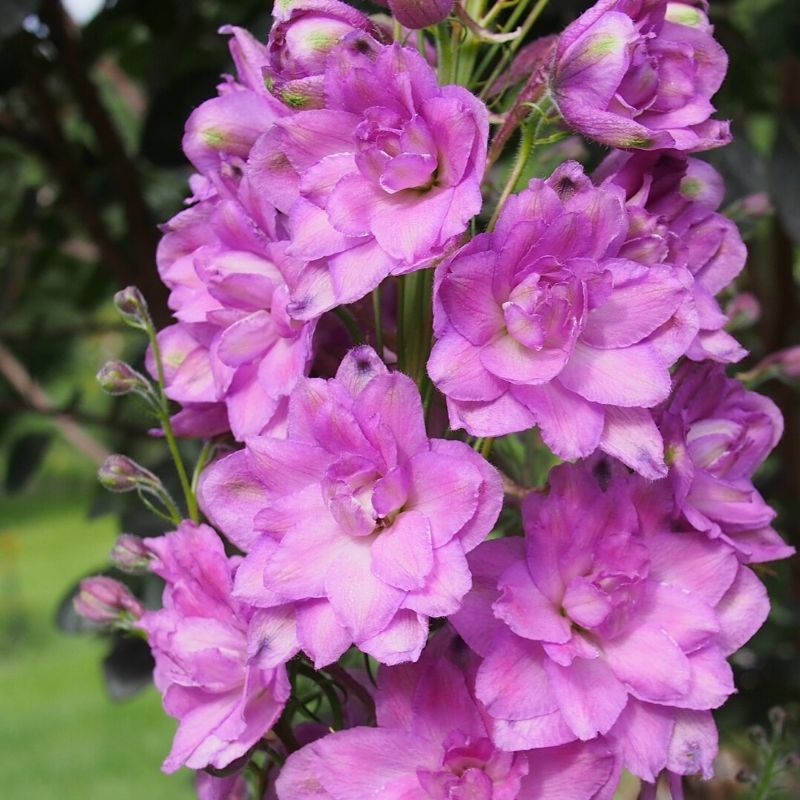
Delphiniums are the flowers symbolizing attachment which is based on the fact that they are very tall and usually need support to stand and grow stable. They are often used in gardens for high blooming accents or in indoor vase floral decorations.
They prefer well-drained soil and areas with full sunlight during the majority of the daytime. However, you have to keep in mind that, despite enjoying sunlight, they are not easily grown in extremely hot, humid and windy weather, so if you live in such an area, you might reconsider your choice.
Violets

Violets are very often related to happiness and are not only a great colorful addition to your garden, but can also be a part of your home-made cuisine because they are edible flowers.
You can see them used as a decoration in plates serving desserts and salads or even as an ingredient in some more modern recipes. They come in many different colors, including pink, blue, purple, yellow, orange, and burgundy.
Violets like a lot of sun, well-drained soil and moderate watering. If taken care of well, they can bloom continuously throughout the spring and summer seasons.
Antirrhinum
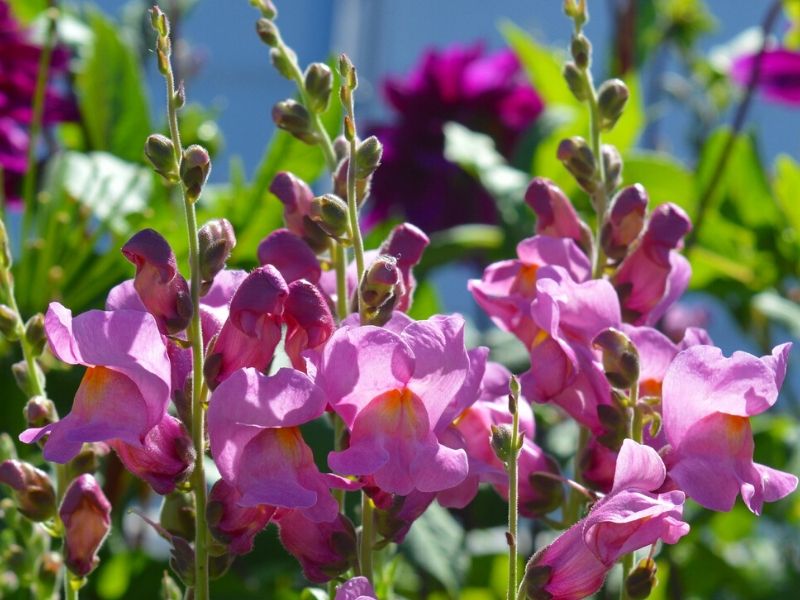
This is a perennial flower which has a long blooming period which is why it is often preferred for well-planned gardens which prefer to have colorful blossoms until the first winter days.
In order to encourage more and longer blooming, remove dead blossoms from the stains and ensure that the flower is planted in well-drained soil.
Chrysanthemum

These flowers come in a wide range of shapes, sizes, and colors of the whole palette. The flower comes from China where it has been cultivated for more than six centuries ago and used as an herb.
Varying types of chrysanthemums are grown differently but most of them are relatively big and also used as cut flowers in bouquets and floral decorations. The blossoms of this flower are each a small floret.
Generally, chrysanthemums bloom in the autumn and are among the top choices of gardeners for this season. However, if cared for well, they can bloom in other periods too.
These flowers prefer sunny places and well-drained soil combined with regular watering. The removal of dead blossoms encourages longer and heavier future blooming.
Trifolium Rubens ‘Red Feathers’
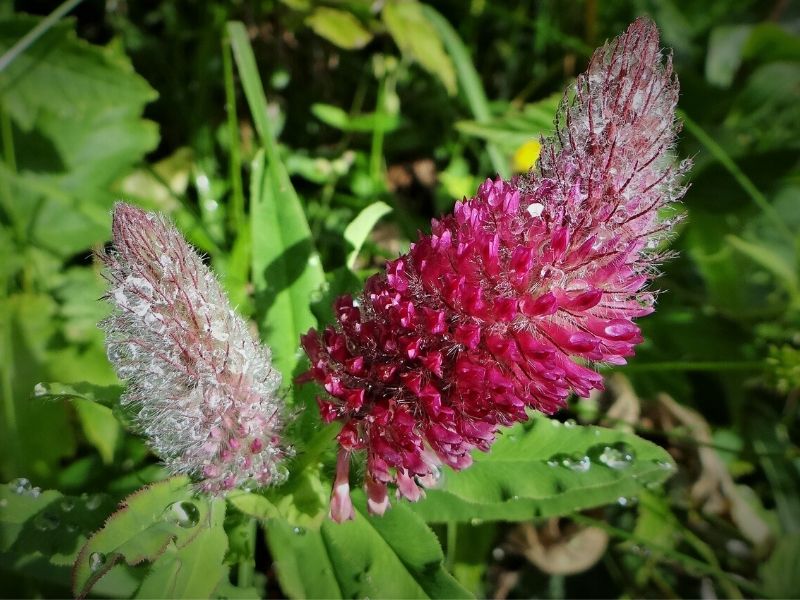
Despite originally being a wild flower, this plant is often planted in gardens because of its pretty flowers and its ability to attract bees and butterflies. It blooms most when exposed to full sunlight and planted in moist or dry soil.
Bergenia
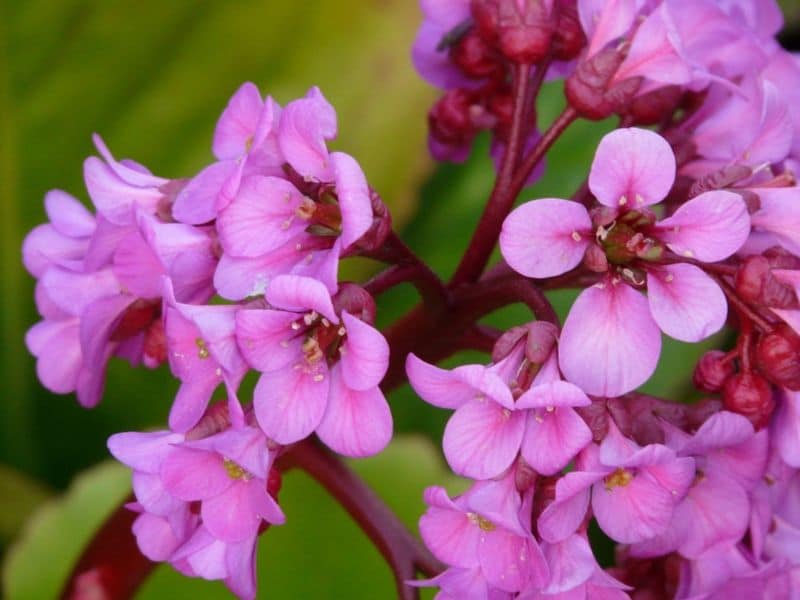
This pretty flower is often used for ground-cover purposes as it spreads relatively slowly. It has dark green foliage above which it blooms with large pink rosettes full of little blossoms.
It is very resistant to changing conditions and weather which makes it relatively easy to grow and care and characterizes it as a low-maintenance flower.
It prefers partial to full shade with no direct sunlight for a long period of the day time. It enjoys well-drained soil and moderate watering.
Rose Thrift
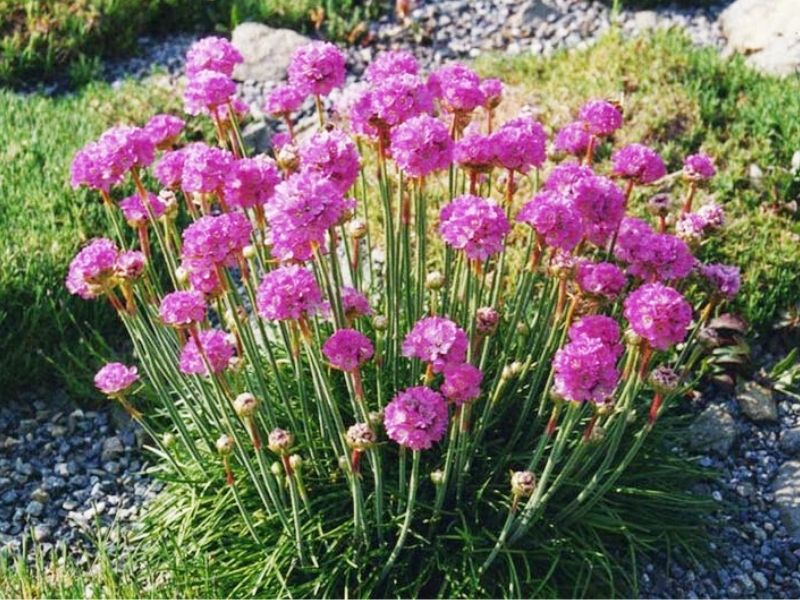
What distinguishes rose thrifts from the majority of other plants in your garden is the easy planting along the edge of a bed or border, or simply among a rocky foundation.
It provides a fairy look. It is very often used for a background of taller flowers or a garden section with trees as it grows up to 6 to 8 inches height and spreads relatively quickly.
Cherry Tree
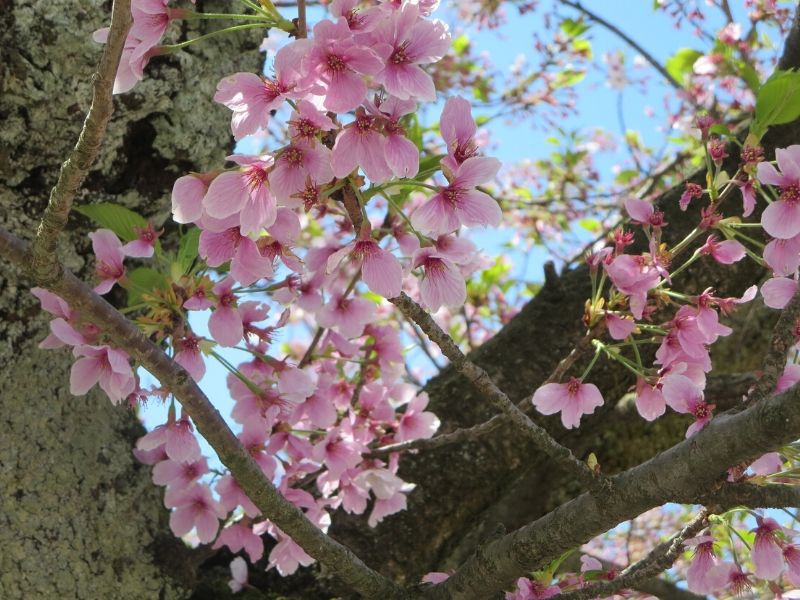
Being one of the distinctive symbols of Japan, this tree offers an amazing beauty and unique design of every garden.
Many people know how pretty these trees are but just a few are aware that its blossoms are also edible. If you choose to plant this tree in your garden you will enjoy its branches full of blossoms throughout the spring season.
Coneflower

This is a perfect choice if you want a flower which will bloom regularly and continuously during the summer season and attract a vast number of butterflies.
Another advantage of this beauty is that it is very resistant to high temperatures and drought which significantly decreases the efforts needed to grow it well. It blooms most when exposed to full sunlight and planted in well-drained soil.
It can grow up to 4 feet in height and 3 feet in width. It is one of the most commonly selected summer flowers which become a pretty accent in a well-planned garden.
Dahlia
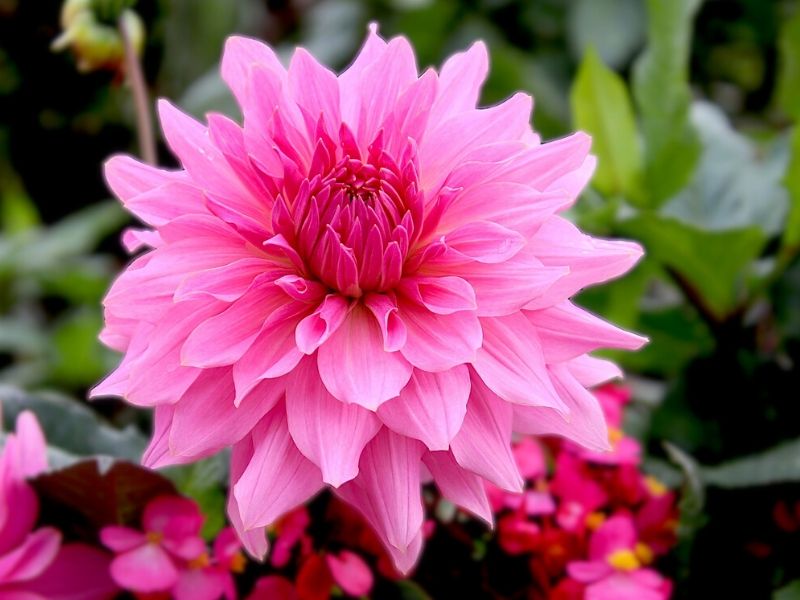
This plant comes in a rich color palette variety and forms beautiful tall flowers which are very often used for bouquets and floral decorations. It blooms in the summer season and is grown from bulbs.
The size and shape of dahlia would depend on the selected sort and ranges from 3 inches to 6 feet in height. Dahlias bloom and grow best when exposed to full sunlight and planted in well-drained soil.
Anemone
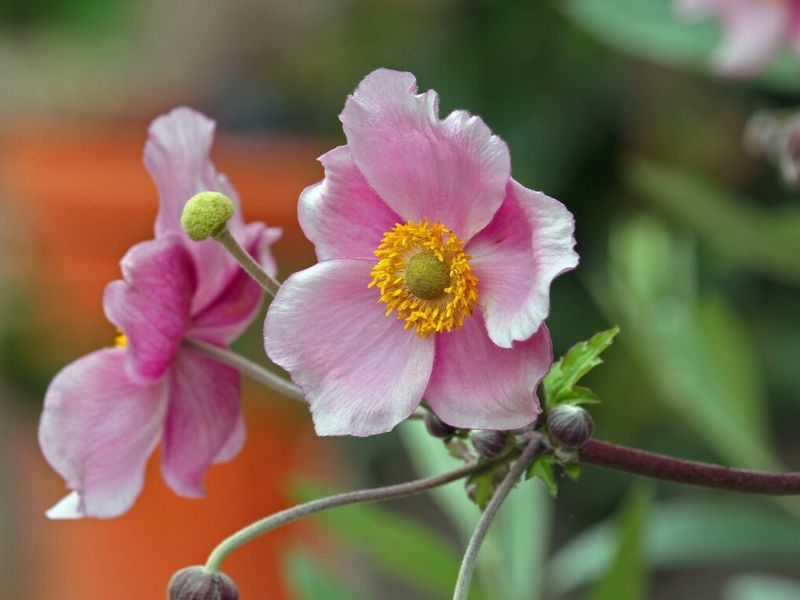
Anemones are preferred due to the relatively long blooming period they have covering spring, summer and autumn seasons. It is the flower that symbolizes luck and many people perceive it as bringing spiritual peace of mind.
It is grown from bulbs, which you can plant in the winter as it starts developing only three months after planting. When planning your anemone corner, keep in mind that one bulb can bloom up to 20 times per year, so you might consider planting a higher number of bulbs.
The flower grows best in well-drained soil and full sunlight or partial shade and can reach up to 36 inches height.
Mandevilla
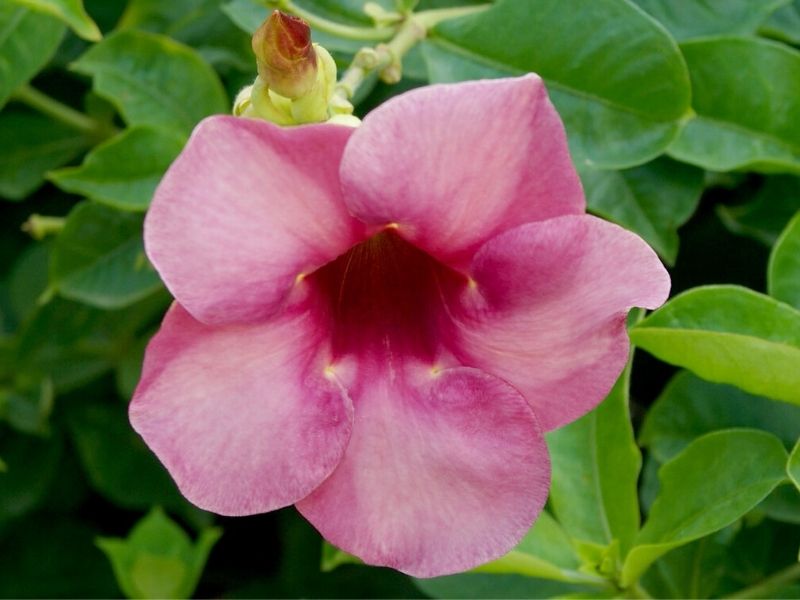
This is one of the easiest to grow vines which will give your garden a soft look of beautiful pink flowers during the whole summer. This plant is relatively easy to maintain and grows quickly, so you have to keep this in mind when you decide how many of these to plant in a limited space.
It can grow up to 20 feet of height and prefers full but indirect sunlight during most of the day and well-drained soil. If exposed to the sun all of the time, it can burn.
Snapdragon
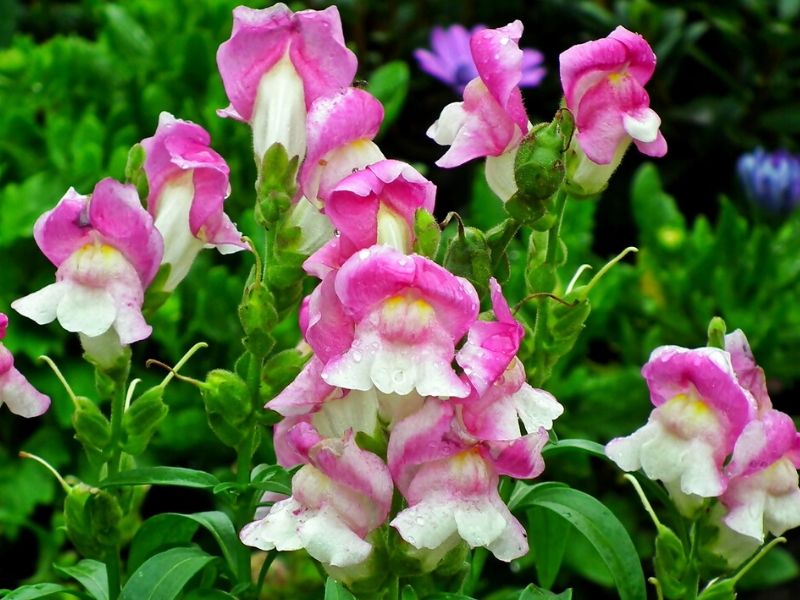
These snapdragon flowers are amazingly beautiful especially when the whole variety of colors are mixed and planted together, including white, yellow, pink, violet, purple, red, burgundy, orange and creamy palettes.
These flowers are very well resistant to cold weather and the best time period to plant them is in late winter. This will contribute to a better root development and blooming when grown.
They generally bloom in the spring and/or the autumn seasons which makes them a perfect contribution to almost any garden design.
Dactylorhiza

This amazingly pretty flower also known as marsh orchid is wild in nature but can easily be grown in gardens too. It is sometimes referred to as ‘spotted orchid’ due to its blossoms’ pattern.
It has a low-growing foliage and a high-rising stain rich with beautiful flower crowns. It is relatively resistant to different changes in the surrounding environment and conditions which makes it a perfect choice for low-maintenance gardens.
Hollyhock
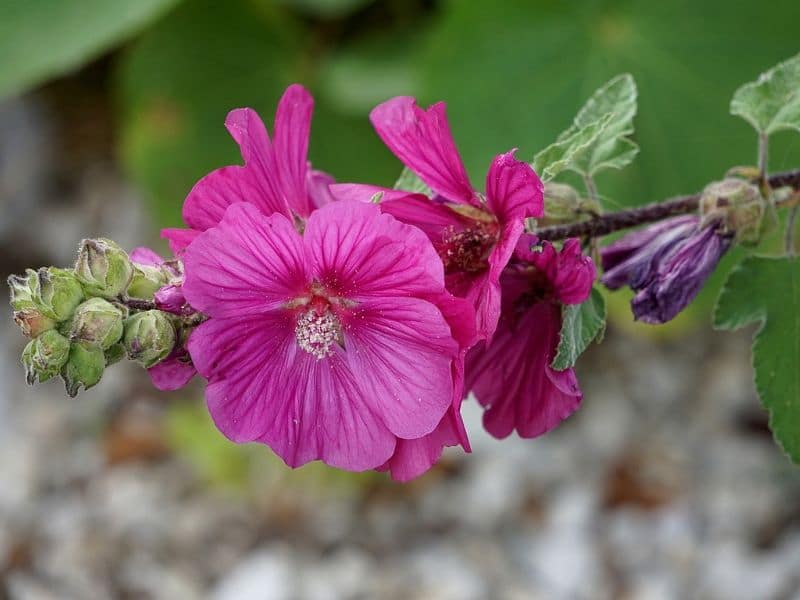
Hollyhocks are often used in gardens and chosen for the beauty of their flowers and their shape which is assumed to blend well with any design and be a pretty accent of any decoration.
These flowers can grow up to 8 feet in height and 3 feet in width and bloom more when exposed to full sunlight and planted in well-drained soil. They are relatively resistant to drought which minimizes the efforts needed to take care of them.
Crabapple Tree
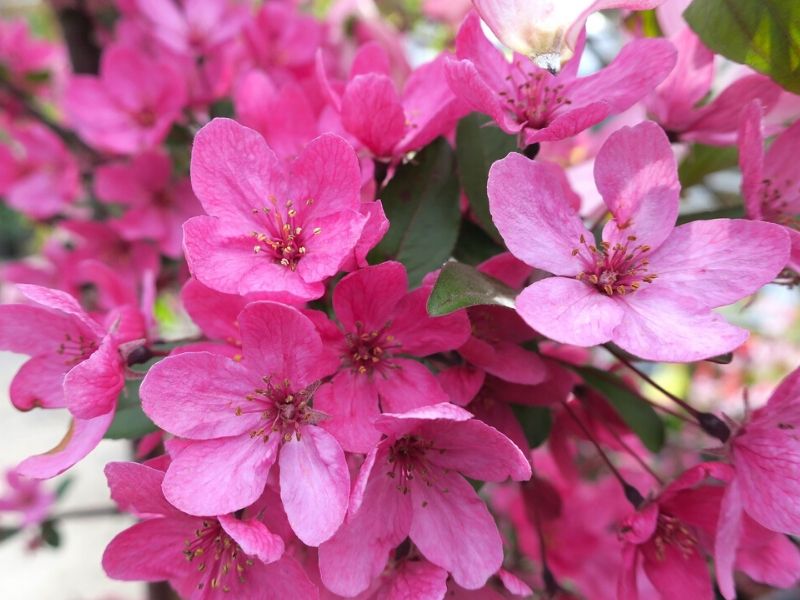
Crabapple trees are completing the spring garden design with its beautiful and rich pink blossoms.
They grow best when exposed to full sun and planted in well-drained soil and will also reward you for your efforts with apple fruits later in the year. They can grow up to 25 feet in height depending on the selected sort.
Veronica

This plant comes in many varieties and colors and is considered ideal for smaller gardens. It attracts butterflies and hummingbirds with its strong colorful flowers that can grow up to 6 inches or 3 feet in height, depending on the specific sort chosen.
It grows in areas with full sunlight or partial shade and prefers well-drained soil. It is preferred by gardeners mainly due to its resistance to changing conditions and its relatively long blooming period covering three seasons, including spring, summer, and autumn.
It is also found attractive by butterflies and hummingbirds which provides you with a potential of having your own back-yard fairy tale.
Turtlehead

This flower (known as Chelone) is also among the top choices of gardeners when they are planning their autumn blooming piece of paradise. Turtleheads get their name from the distinctive shape of their blossoms.
The flower prefers muddy and swampy soil and areas to grow but can also be planted in shady areas with regular watering. It can grow up to 3 feet of height and width.
Astilbe

This low-grown plant is very often used for ground cover because of its beautiful green foliage which is topped with soft pink blossoms. Varying types of astilbe plants bloom in different periods but, in general, their flowers are formed in late summer and early autumn.
This flower is well resistant to drought which makes it a perfect choice for low-maintenance gardens. Astilbe can grow up to 11 inches in height and 17 inches in width. The flower prefers sunny places and average watering.
Carnation
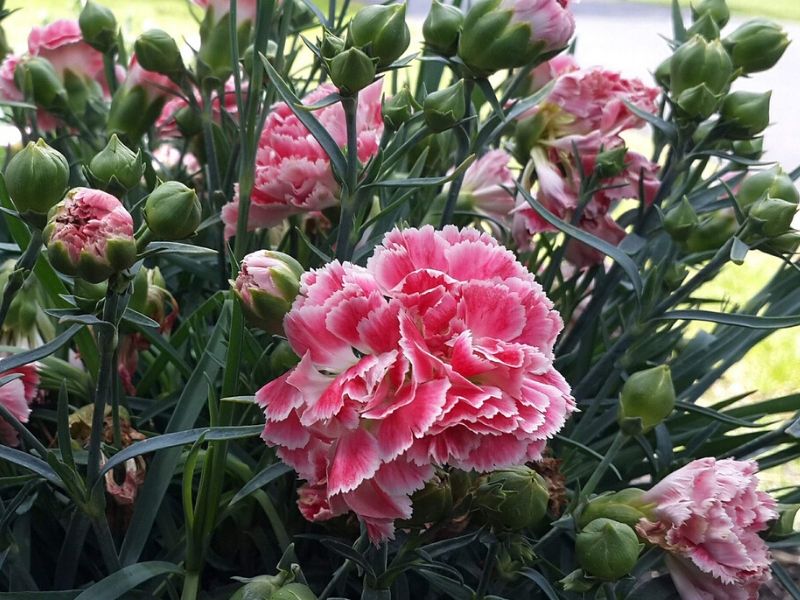
Carnations also come in a wide variety of colors and sizes depending on the sort and are a good filler of garden gaps. If you plant them in an area where they will have at least a couple of hours of direct sunlight and well-drained soil, they will bloom from spring to autumn.
They require moderate watering, so they are quite easy to maintain. To encourage stronger grow and more blooming you might remove the dry parts of the plant and the blossoms after they die.
Most of the carnation sorts come with a strong aromatic fragrance and attract many butterflies and birds, making your garden a real paradise.
Heuchera
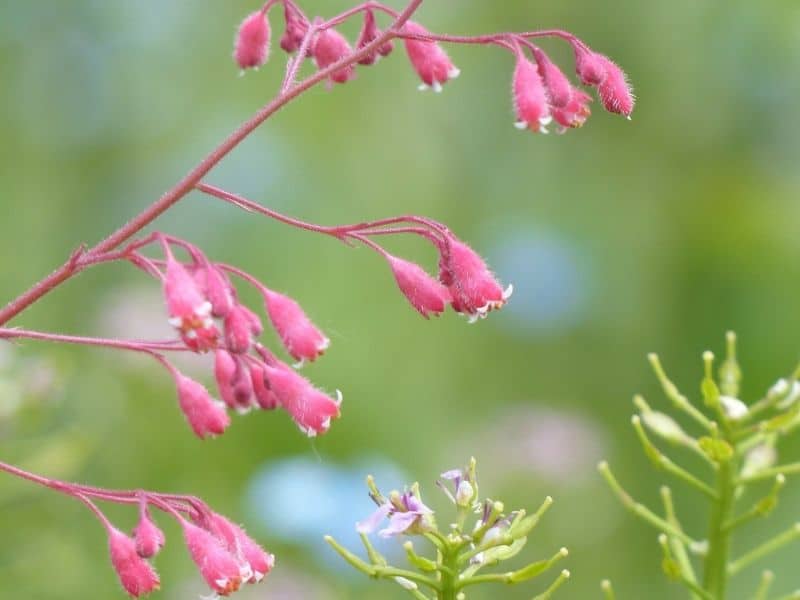
This flower (known as Coral bells) is also often preferred when planning a garden design due to its distinctive shape – it has low foliage which is colored in green and grey color varieties and tall stains with rich of a vast number of small delicate pink flowers.
This provides an opportunity for filling your garden’s gaps on the ground and at the same time giving it more color with the tall spears of blossoms. This plant blooms throughout the whole summer, so you will enjoy its beauty for long.
Bleeding Heart

This perennial is ideal to cover shady areas in your garden as it grows best in full shade and well-drained soil. Its foliage and heart-shaped, rich-colored blooms are a gorgeous addition to any garden design.
The plant can grow up to 4 feet in height and 3 feet in width which makes it a perfect fit for covering areas which are not commonly chosen for planting flowers due to lack of direct sunlight.
Iberis
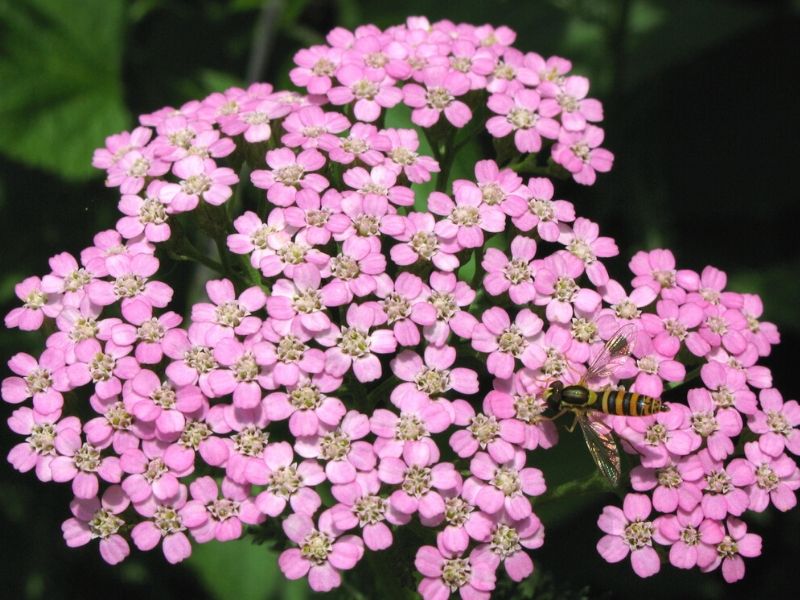
Commonly called candytuft, this is a relatively short flower which makes it perfect for ground cover of taller plants. It is very resistant to poor soil and changing weather conditions which also makes it easy to grow and care.
It blooms with pink and purple flowers and also enjoys the eye with beautiful green foliage. Despite being an annual plant, it is an amazing addition to any garden design.
Foxglove

This is believed to be one of the most majestic pink flowers which you can have in your garden. It doesn’t require a lot of maintenance which further contributes to its advantages.
Most of the foxglove varieties are biennials. They grow and develop roots during the first year, bloom on the second one and then die. However, during the blooming period, foxgloves drop seeds which make new crops during the years after.
Foxgloves can grow up to 6 feet in height and 2.5 feet in width and prefer partial shade with some sunlight and well-drained soil. Keep in mind that all parts of the plant are partially toxic, so keep it away from kids and pets.
Bougainvillea
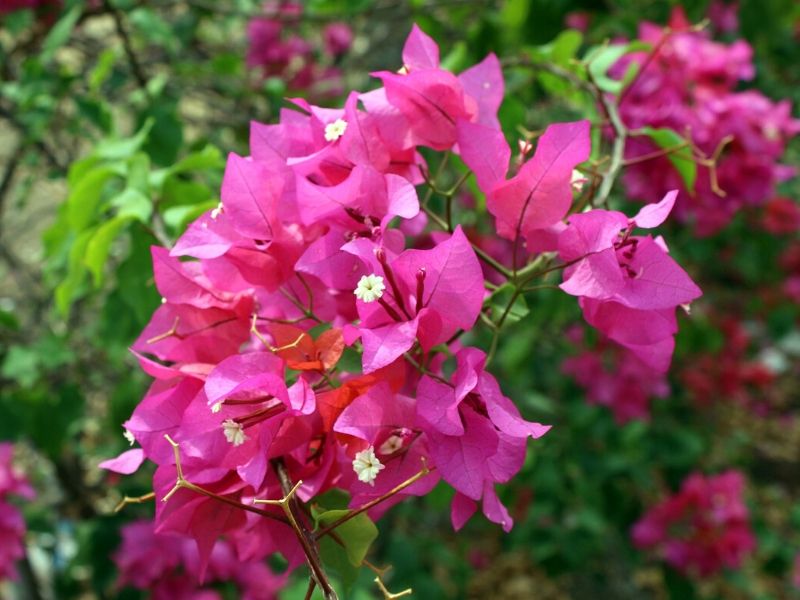
This is one of the most amazing and breath-taking climbing blooming bushes that you can have in your garden. It is relatively easy to grow and care and develops well in areas with a temperate climate.
This bush is blooming almost all year round and comes in a variety of colors, including pink, red, burgundy and purple. Maintenance and care depend on the variety and sort chosen but, in general, it prefers sunny areas combined with well-drained soil and regular watering.
However, it is quite resistant to drought and changing climate conditions which makes it a relatively low maintenance plant. In return, it rewards its owners with impressive flowers in rich colors which will definitely make your garden a real superstar.
Zinnia

This is a very popular garden flower which comes in a wide variety of colors, including pink, purple, burgundy, yellow, red and white. It blooms continuously and makes a wonderful cut flower for floral decorations and bouquets as well.
Phlox
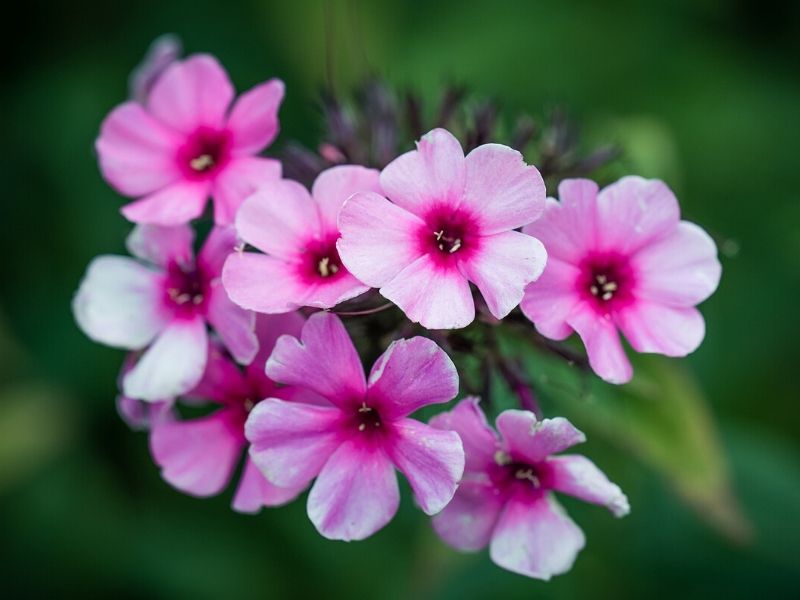
This is a very popular and commonly used flower for gardens that want a pretty summer blooming. It is a perennial which forms flowers with strong aromatic fragrance.
This flower can grow up to 4 feet in height and 3 feet in width and cover this area with hundreds of pink blossoms which makes it an impressive addition to any garden design.
Paeonia Lactiflora

This is also known as a Japanese peony. This flower has an extremely rich color and comes in different color palette variations. Its distinctive beauty is also characterized with creamy center of the blossom.
Due to its rich color, it is often used as a borderline in garden edges or to divide garden areas. It usually blooms in midsummer period.
What Are Some Other Beautiful Pink Flowers?

The list of bright pink flowers you can grow doesn’t end there! There are many other types of pink flowers. Here are some of the best bright pink flowers with green foliage to consider:
- Calla lily
- Butterfly bus
- Pink carnations
- Sweet pea
- Arum lily
- Rose thrift
- Bee balm
- Spider lily
- Wand flower
- False goat’s beard
- Lathyrus odoratus
- Bleeding heart
- Cosmos bipinattus
- Dianthus caryophyllus
- Vinca minor
- Veronica spicata
- Papaver orientale
- Alcea rosea
- Lilium orientalis
- Nelumbo nucifera
- Hyacinthus orientalis
How to Choose Pretty Pink Flowers That Work Well in Your Garden

As you may have gathered already by reading this post, there isn’t a one-size-fits-all approach when it comes to choosing the best types of pink flowers for your garden.
Sure, there are the aesthetic considerations – do you prefer light pink flowers, bright pink flowers, or pink blooms that are so dark they’re almost red? – but you also need to consider your environment to choose the best flowering plants.
There are flowers available in different shades of pink for just about any environment, but you need to do some planning to make sure your pink flowers will survive.
Climate Zone
Some climates take a long time to warm up in early spring, so certain pink blooms may not be the best choice because they prefer a warmer climate (like the hibiscus).
Similarly, some pink flowers are delicate flowers that can’t handle the heat in warmer climates. They may get too hot in early summer or early fall (or even late spring, in very hot areas), so you’ll need to bring them inside to protect them from the heat.
Full Sun vs Light Shade

What does the sun exposure look like? Most of these small pink flowers like full sun, but there are some that prefer some light shade.
Care Requirements
Next, what kind of care requirements do your pink flowers have? Do the dainty pink blooms need to be deadheaded in order to continue producing vibrant flowers? Do the pink petals require regular fertilizing? Do you need to dig bulbs in the early fall?
All of these are important questions to ask to make sure your tiny flowers thrive, regardless of what you grow and where you live.
Planting Area

A final question to ask is where you plan to grow your new gorgeous flowers. Most of these flowers grow well in any setting, from a flower bed to a hanging basket or even directly in the ground. From container plants to border plants, hanging baskets to window boxes, you have a lot of options for where you want to plant your pink flowers.
That said, some pink flowers prefer to be grown in raised beds while others like containers. Think, too, about your preferences for planting.
Do you want to plant your pink flowers along a walkway, where you can enjoy the showy blossoms every time you arrive home? Or would you rather grow them in a hanging basket on the porch where you can enjoy the fragrant scent wafting across your yard?
Pink Flowering Plants for Any Gardener

Up Next: Top 55+ Types of Blue Flowers with Names and Pictures
There you have it! Some of the most beautiful pink flowers you can grow, regardless of where you live.
Whether you’re looking for pink flowers for a garden border or cut flowers to be used in a wedding bouquet, there’s truly a pink flower out there for everyone.
References
Reference List
(1) Goi, C. (2012) The Impact of Colours on Online Marketing Communications. International Journal of Social, Behavioral, Educational, Economic, Business and Industrial Engineering. Vol. 6 (2), pp. 182-186.
(2) Patil, D. (2012) Coloring Consumer’s Psychology Using Different Shades The of Perception of Colors by Consumers in Consumer Decision Making Process. Journal of Business and Retail Management Research. Vol. 7 (1), pp. 60-73.
(3) Khattak, S., Ali, H., Khan, Y., Shah, M. (2018) Color Psychology in Marketing. Journal of Business and Tourism. Vol. 4 (1), pp. 183-190.
(4) Bortoli, M., Maroto, J. (2011) Translating Colours in Web Site Localisation. Proceedings of the European Languages and the Implementation of Communication and Information Technologies (Elicit) Conference.
Close

